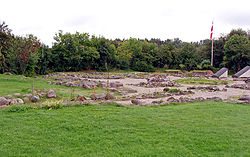Monastery Øm
| Cistercian Abbey Øm | |
|---|---|
 Remains of the monastery church |
|
| location |
Central Jutland region |
| Coordinates: | 56 ° 3 '0 " N , 9 ° 44' 50" E |
| Serial number according to Janauschek |
393 |
| founding year | 1172 |
| Year of dissolution / annulment |
1560 |
| Mother monastery | Vitskøl Monastery |
| Primary Abbey | Clairvaux Monastery |
The monastery Øm ( cara insula, kære ø (= dear island)) (Danish: Øm monastery) was a Cistercian abbey on Mossø , about 4 km southeast of the village of Gammel Rye in the Danish municipality of Skanderborg , Central Jutland . Its foundation walls have been preserved and can be visited.
history
In 1164 gave Bishop Eskil Aarhus the abbot Henrik of Vitskøl land for the monastery in Sabro, in turn, a daughter house of Esrom Monastery in the filiation of Clairvaux was. However, this property was not found suitable, which is why the bishop made land available in Sminge. After a short time, however, the monks moved on to the monastery of Veng, from there to Mossø and then to Øm. The local monastery was settled from Vitskøl monastery in 1172 . In 1182 it was recognized by the Pope. The church choir was consecrated in 1257. It was the 393rd medieval Cistercian abbey.
The monks of Øm also built the eight meter wide Munke Canal with lock systems between Emborg and Boes. Its course can be read in the terrain to this day. The monastery existed until the Reformation in 1536; the last monk left it in 1560. The buildings were then used for a short time as King Frederick II's hunting lodge (“Emborg”), but in 1561 it was demolished. The material was used for the castle in Skanderborg . The village of Emborg grew above the ruins. Excavations took place between 1910 and 1941.
Buildings and plant
The monastery, located between Mossø and Gudensø, was between two canals connecting these lakes. The three-aisled church had a choir with a straight end and two narrow yokes, in which the grave of Bishop Peder is located. Elavøen is located, and a wide transept with two eastern and one two-bay western chapel and a short, single-nave nave. The cloister and cloister were to the right (south) of the church. The nine-bay chapter house had four columns. Since it was demolished in 1561, only the foundation walls have been preserved.
literature
- Rudolf Zeitler: Reclam's Art Guide Denmark , 1978, p. 340, ISBN 3-15-010273-1 .
- Kjeld de fine Licht, Vibeke Michelsen, Niels Jørgen Poulsen: Kirkerne i Rye, Sønder Vissing including the forsvundne klosterkirke i Øm (special print from: Danmarks Kirker. Århus Amt , issue 40), ed. from Nationalmuseet, Poul Kristensens Forlag, Herning 1992.

